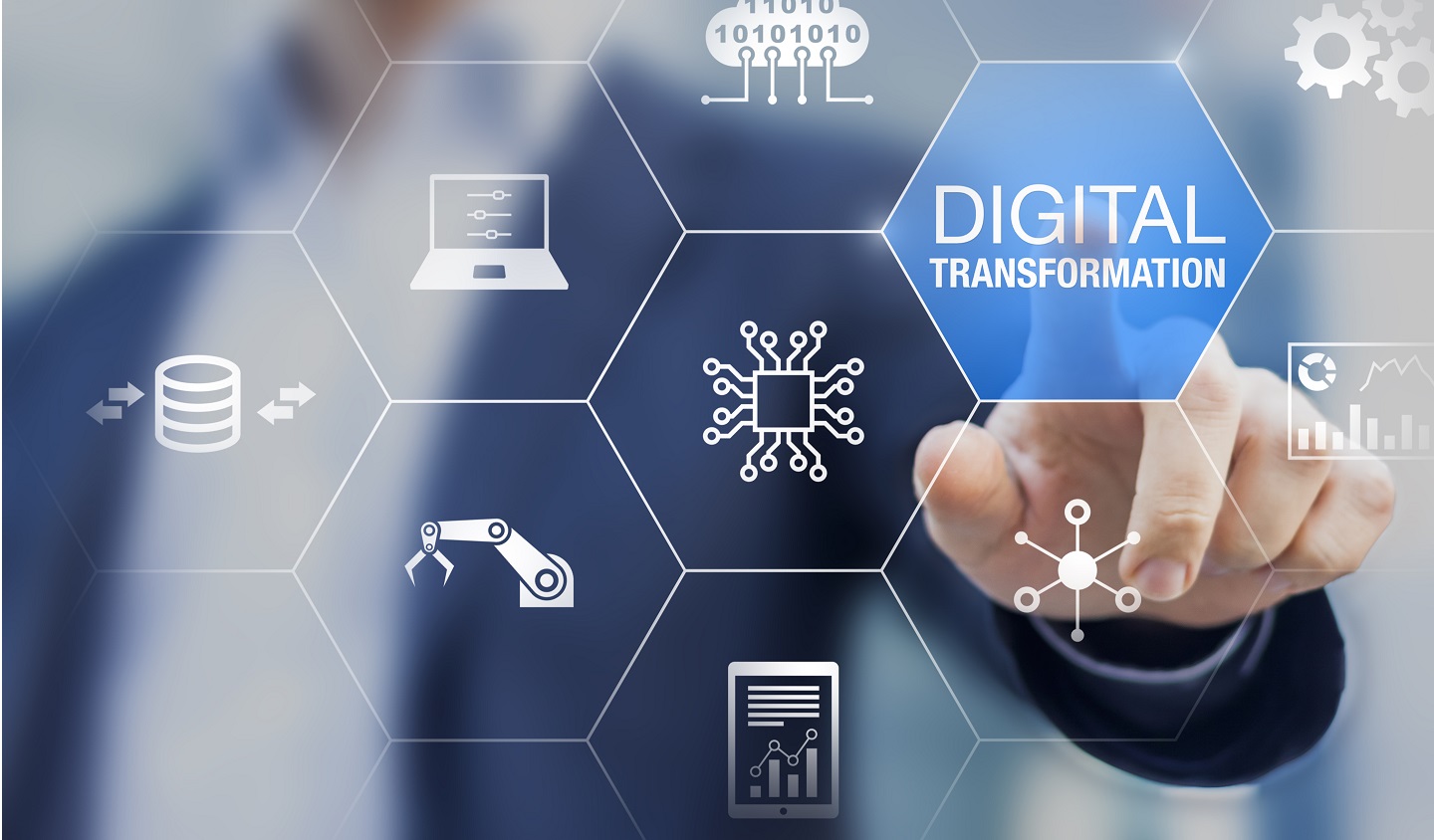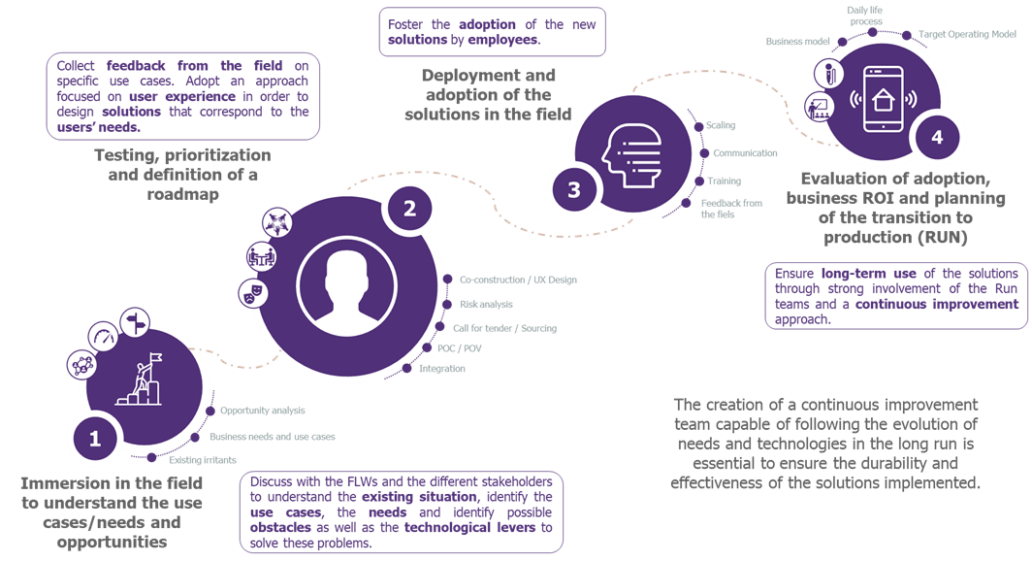A population so far overlooked in digitalization projects
The recent health crisis has highlighted the importance of “frontline” employees, but also the delay in their digitalization. Frontline employees have often been deprioritized in the major transformation projects of these past few years.
However, more than 80% of companies believe that better use of information provided by frontline workers (FLWs) and empowering them would have a major impact on their competitiveness.
Objective reasons for this slow digitalization
The diversity of these populations, of their daily operational life and of their relationship with technology explains why the challenges and needs differ from one sector to another, but also within the same company (sedentary or mobile, operational or maintenance technician…).
In addition, the FLW population is under greater time-to-market pressure. These employees therefore need to be operational very quickly to maintain a constant level of performance, or even to improve it.
All these aspects lead to different technological requirements to efficiently respond to the different needs. So which method should be adopted to address them?
What are the key challenges in the digitalization of FLW?
Companies that have successfully completed the digitization of the FLW work environment mostly report a quick return on investment (Microsoft and Forbes). Key improvements include:

Comfort and safety at work: thanks to the introduction of some digital tools, employees perform fewer unnecessary actions and make fewer movements. They can therefore focus on activities with a higher added value. They have additional information and can be alerted by their tools in case of dangerous situations.

Communication with the field: information often has difficulty passing between the field and office populations, which creates a gap within the company. Digital tools can create this bridge so that everyone is aware of relevant information that impacts their activities.

Operational efficiency: through the dematerialization of certain tasks and the automation of low-impact tasks that can lead to a loss of efficiency and motivation, the frontline worker is then able to focus on what makes their work valuable and therefore produce more and/or to a better standard.
In other words, both company and employees benefit from digitalization. The employee works in better conditions, while the company improves its productivity and optimizes the use of its resources to deliver its goods and services more efficiently and, in the long run, at a lower cost.
Let’s take the example of a road transport company that we supported. Applications that allowed the couriers to optimize their delivery rounds were deployed at the same time as the tablets needed for this use. The new software solution enabled the drivers to know the exact position of the packages in the warehouse and the order in which they should be placed in their trucks according to the delivery round planned, therefore allowing them to gain comfort and operational efficiency.
On the other hand, we can also consider companies that have based their entire management on the digitalization of their FLWs such as Uber, Deliveroo… The experience is fully digital, for the customer as well as for the frontline employee. For the customer, the experience is optimal: they know the status of their request in real time and can see the movement of the driver in the app. They can therefore anticipate the arrival time of the driver. The FLW receives the requests directly in their application which has previously calculated and optimized the task according to their situation. They are then guided through the steps to improve their journey or adapt it to the situation. However, this intense digitalization leads to the question of alienation at work (some even mention a form of modern slavery), which requires an in-depth social dialogue and the inclusion of all parties in the digitalization process.
Digitalizing FLW: a vast technological field
What is behind the digitalization of the frontline workers’ work environment?
An important requirement for any digitalization ambition, is to have a modern IT base with infrastructures and a network capable of hosting future technologies and associated services. Promising projects can fail, not because of the technology itself, nor even the relevance of the service developed, but only because of obsolete infrastructures and therefore a negative perceived quality of service (latency, server saturation, etc.).
Without mentioning the business tools specific to each field that are essential to a modern company (WMS, ERP, CMMS, etc.) and that are not the subject of this article, there are several technological levers that can transform the Frontline Workers’ work environment. We have identified 4 major pillars on which companies can act to enable this digitalization.
This first pillar is a prerequisite to address the 3 following ones. Providing mobile devices to frontline workers will allow a better access to information. For example, a maintenance worker on the move who produces paper reports will be able to write up their report directly on their mobile device in order to reuse it more easily.
Beyond the IT base and infrastructure, the devices used by FLWs must be in line with the market (Windows 10 LTSC, Android, etc.) in order to accommodate the future services and applications that are to be implemented. EMM (Enterprise Mobile Management) solutions are progressively expanding to become the standard for managing all of the company’s mobile devices, whether they are used within its network or outside.
Among the multiple administrative and mechanical tasks assigned to FLWs, some require few specific skills. They can be optimized or even automated. If we take the example of our maintenance agent writing paper reports, a scanning platform will allow the report to be sent directly to the parties involved without having to scan it.
This will increase efficiency while reducing the risk of human error.Automation can involve things as simple as a HTML form, which would replace a sheet or Excel form requiring consolidation work, but also more complex and emerging technologies like RPA (Robotic Process Automation). In between, Low Code / No Code technologies such as Microsoft’s Power Platform can also be exploited to quickly create virtual applications or processes that would replace tasks initially carried out by humans.
To meet one of the pillars mentioned earlier, it is essential to rethink the way information is transmitted between the field and office populations, but also within each of these groups. One of the technological approaches to consider is the adaptation of collaborative suites (Office 365, Google Workspace…) for frontline workers.
So far, companies have focused on their office teams for which these solutions seem to have been designed and the benefits are obvious. Nevertheless, the major market players are increasingly developing their solutions to meet the challenges of the field populations. Let’s take the example of a luxury group that has deployed tablets with Teams for its sales agents. The possibility of integrating schedule management via Shift or other applications within the Teams mobile application, allows salespeople to have a single application to communicate and collaborate with the rest of the company.
Technologically advanced companies that have already addressed at least some of the previous pillars may also be interested in emerging technologies that promise to “augment” FLWs. By “augment“, we mean frontline workers having all the relevant information in real time, in order to carry out their ongoing task.
This can involve connected solutions that will provide real-time data on the way a tool is used to ensure that it is handled properly (Qubes), or a solution that will alert FLWs about the inconsistency of a variable that is useful for the performance of their tasks. We can also talk about AR/VR (Augmented/Virtual Reality) and especially the role it can have in training and remote assistance. For example, a maintenance agent could remotely repair a machine using these technologies to reduce the loss of travel time while ensuring a good level of assistance.
What methodology should be adopted to successfully digitalize FLW?
We believe that the approach must always start from concrete use cases, and not try to push a specific technology at all costs without taking the operational needs into account.
To implement this approach, we recommend a 4-step process:
The approach suggested above is the result of several of our missions with large groups. The current health crisis has shown us that it is necessary to accelerate the digitalization of these populations. This is especially true since the young companies that are emerging today and employing FLWs mostly base their operations on digital tools. These tools bring a real added value to the customer while optimizing and automating the activities that must be carried out by the FLWs. Large companies have no choice but to upgrade themselves to remain competitive. It is now time to fill the gap between “frontline” and “office” workers when it comes to digitalization!







